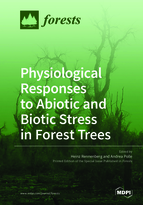Physiological Responses to Abiotic and Biotic Stress in Forest Trees
A special issue of Forests (ISSN 1999-4907). This special issue belongs to the section "Forest Ecophysiology and Biology".
Deadline for manuscript submissions: closed (28 February 2019) | Viewed by 64695
Special Issue Editors
Interests: nitrogen and phosphorus nutrition; nitrogen and sulfur metabolism; abiotic and biotic stress physiology; biogenic emissions; phytoremediation
Special Issues, Collections and Topics in MDPI journals
Special Issue Information
Dear Colleagues,
As sessile organisms, plants have to cope in their environment with a multitude of natural and anthropogenic forms of stress. Due to their longevity, this is of particular significance for trees. As a consequence, trees developed an orchestra of resilience and resistance mechanisms to biotic and abiotic stresses in order to support their growth and development in a constantly changing atmospheric and pedospheric environment. The objective of this Special Issue of Forests is to summarize state-of-art knowledge and to report current progress on processes that determine resilience and resistance of trees from different zonobiomes to all forms of biotic and abiotic stress from the molecular to the whole tree level by review articles and original research papers.
Prof. Dr. Heinz Rennenberg
Prof. Dr. Andrea Polle
Guest Editors
Manuscript Submission Information
Manuscripts should be submitted online at www.mdpi.com by registering and logging in to this website. Once you are registered, click here to go to the submission form. Manuscripts can be submitted until the deadline. All submissions that pass pre-check are peer-reviewed. Accepted papers will be published continuously in the journal (as soon as accepted) and will be listed together on the special issue website. Research articles, review articles as well as short communications are invited. For planned papers, a title and short abstract (about 100 words) can be sent to the Editorial Office for announcement on this website.
Submitted manuscripts should not have been published previously, nor be under consideration for publication elsewhere (except conference proceedings papers). All manuscripts are thoroughly refereed through a single-blind peer-review process. A guide for authors and other relevant information for submission of manuscripts is available on the Instructions for Authors page. Forests is an international peer-reviewed open access monthly journal published by MDPI.
Please visit the Instructions for Authors page before submitting a manuscript. The Article Processing Charge (APC) for publication in this open access journal is 2600 CHF (Swiss Francs). Submitted papers should be well formatted and use good English. Authors may use MDPI's English editing service prior to publication or during author revisions.
Keywords
- climate change
- heat
- drought
- water logging
- salt stress
- soil contamination
- parasites
- pathogens
- herbivore







